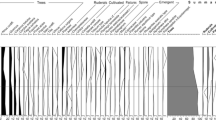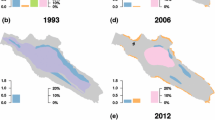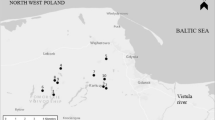Abstract
An overgrowth of invasive floating macrophytes can occur in shallow eutrophic lakes as a result of significant anthropogenic pressures. This necessitates appropriate monitoring, followed by informed management, control and mitigation actions. In this study, we explored the long-term dynamics of macrophyte stands in a fluvial-wetland system and the influence of mechanical removal alongside environmental drivers. The Landsat imagery archive was used to analyze the areal coverage and canopy density of both autochthonous and allochthonous macrophytes in the Mantua lakes system (Northern Italy). Satellite derived data showed a substantial increase in the extent of the alien Nelumbo nucifera, and Ludwigia hexapetala, and the native Trapa natans over a timescale of decades, possibly caused by the temporary absence of macrophyte removal and altered hydrology. According to spectral proxies, N. nucifera recorded consistently the highest density in the system. T. natans density was found to respond to the maximum summer temperature and Eastern Atlantic climatic index, reflecting the role of regional climatic controls. This approach may be transferred to inland waters from regional to global scale exploiting satellite archives to obtain a time series on changing species dynamics essential for the conservation and management of aquatic habitats.







Similar content being viewed by others
Data Availability
The datasets generated during and/or analysed during the current study are available from the corresponding author on reasonable request. Landsat imagery is available at https://earthexplorer.usgs.gov/.
References
Baruch Z, Goldstein G (1999) Leaf construction cost, nutrient concentration, and net CO2 assimilation of native and invasive species in Hawaii. Oecologia 121:183–192. https://doi.org/10.1007/s004420050920
Boerema A, Schoelynck J, Bal K, Vrebos D, Jacobs S, Staes J, Meire P (2014) Economic valuation of ecosystem services, a case study for aquatic vegetation removal in the Nete catchment (Belgium). Ecosystem Services 7:46–56
Bolpagni R, Piotti A (2016) The importance of being natural in a human-altered riverscape: role of wetland type in supporting habitat heterogeneity and the functional diversity of vegetation. Aquatic Conservation: Marine Freshwater Ecosystems 26(6):1168–1183
Bolpagni R, Bresciani M, Laini A et al (2014) Remote sensing of phytoplankton-macrophyte coexistence in shallow hypereutrophic fluvial lakes. Hydrobiologia 737(1):67–76
Bresciani M, Rossini M, Morabito G et al (2013) Analysis of within-and between-day chlorophyll-a dynamics in Mantua Superior Lake, with a continuous spectroradiometric measurement. Marine Freshwater Research 64(4):303–316
Bresciani M, Giardino C, Lauceri R et al (2017) Earth observation for monitoring and mapping of cyanobacteria blooms. Case studies on five Italian lakes. Journal of Limnology 76(Suppl 1):127–139
Bukata RP (2005) Satellite monitoring of inland and coastal water quality: retrospection, introspection, future directions. CRC Press, Taylor, 272 pp
Callaway RM, Aschehoug ET (2000) Invasive plants versus their new and old neighbors: a mechanism for exotic invasion. Science 290:521–523
Caraco N, Cole J, Findlay S, Wigand C (2006) Vascular plants as engineers of oxygen in aquatic systems. Bioscience 56(3):219–225
Davidson AM, Jennions M, Nicotra AB (2011) Do invasive species show higher phenotypic plasticity than native species and, if so, is it adaptive? A meta-analysis. Ecology Letters 14:419–431. https://doi.org/10.1111/j.1461-0248.2011.01596.x
Dudgeon D, Arthington AH, Gessner MO et al (2006) Freshwater biodiversity: importance, threats, status and conservation challenges. Biological Reviews 81(2):163–182
Fasoli JVB, Mormul RP, Cunha ER, Thomaz SM (2018) Plasticity responses of an invasive macrophyte species to inorganic carbon availability and to the interaction with a native species. Hydrobiologia 817:227–237. https://doi.org/10.1007/s10750-018-3543-x
Fensholt R, Proud SR (2012) Evaluation of earth observation based global long term vegetation trends Comparing GIMMS and MODIS global NDVI time series. Remote Sensing of Environment 119:131–147
Finlayson CM, Davis JA, Gell PA, Kingsford RT, Parton KA (2013) The status of wetlands and the predicted effects of global climate change: The situation in Australia. Aquatic Sciences 75(1):73–93
Fisher JI, Richardson AD, Mustard JF (2007) Phenology model from surface meteorology does not capture satellite-based greenup estimations. Global Change Biology 13(3):707–721
Goodwin K, Caraco N, Cole J (2008) Temporal dynamics of dissolved oxygen in a floating-leaved macrophyte bed. Freshwater Biology 53:1632–1641
Groth AT, Lovett-Doust L, Lovett‐Doust J (1996) Population density and module demography in Trapa natans (Trapaceae), an annual, clonal aquatic macrophyte. American Journal of Botany 83(11):1406–1415
Hestir EL, Khanna S, Andrew ME et al (2008) Identification of invasive vegetation using hyperspectral remote sensing in the California Delta ecosystem. Remote Sensing of Environment 112(11):4034–4047
Huang C, Wang X, Yang H, Li Y, Wang Y, Chen X, Xu L (2014) Satellite data regarding the eutrophication response to human activities in the plateau lake Dianchi in China from 1974 to 2009. Science of the Total Environment 485:1–11. https://doi.org/10.1016/j.scitotenv.2014.03.031
Hunter PD, Gilvear DJ, Tyler AN, Willby NJ, Kelly A (2010) Mapping macrophytic vegetation in shallow lakes using the Compact Airborne Spectrographic Imager (CASI). Aquatic Conservation: Marine Freshwater Ecosystems 20:717–727
Hussner A, van Dam H, Vermaat JE, Hilt S (2014) Comparison of native and neophytic aquatic macrophyte developments in a geothermally warmed river and thermally normal channels. Fundamental and Applied Limnology 185:155–165. https://doi.org/10.1127/fal/2014/0629
Hussner A, Stiers I, Verhofstad MJJM, Bakker ES, Grutters BMC, Haury J, Anderson LWJ (2017) Management and control methods of invasive alien freshwater aquatic plants: a review. Aquatic Botany 136:112–137
Jacobs AE, Harrison JA (2014) Effects of floating vegetation on denitrification, nitrogen retention, and greenhouse gas production in wetland microcosms. Biogeochemistry 119(1–3):51–66
Jeppensen E, Jensen JP, Søndergaard M, Lauridsen T, Pedersen LJ, Jensen L (1997) Top-down control in freshwater lakes: the role of nutrient state, submerged macrophytes and water depth. Hydrobiologia 342/343:151–164
Jeppesen E, Meerhoff M, Davidson TA et al (2014) Climate change impacts on lakes: an integrated ecological perspective based on a multi-faceted approach, with special focus on shallow lakes. Journal of Limnology 73(s1):88–111
Jia Q, Cao L, Yésou H, Huber C, Fox AD (2017) Combating aggressive macrophyte encroachment on a typical Yangtze River lake: lessons from a long-term remote sensing study of vegetation. Aquatic Ecology 51(1):177–189
Jordan SJ, Stoffer J, Nestlerode JA (2011) Wetlands as sinks for reactive nitrogen at continental and global scales: A meta-analysis. Ecosystems 14:144–155
Keane RM, Crawley MJ (2002) Exotic plant invasions and the enemy release hypothesis. Trends in Ecology & Evolution 17:164–170. https://doi.org/10.1016/S0169-5347(02)02499-0
Kosten S, Jeppesen E, Huszar VL et al (2011) Ambiguous climate impacts on competition between submerged macrophytes and phytoplankton in shallow lakes. Freshwater Biology 56(8):1540–1553
Kurihara M, Ikusima I (1991) The ecology of the seed in Trapa natans var. Japonica in a eutrophic lake. Vegetatio 97(2):117–124
Leoni B, Nava V, Patelli M (2018) Relationships among climate variability, Cladocera phenology and the pelagic food web in deep lakes in different trophic states. Marine and Freshwater Research 69:1534–1543
Liira J, Feldmann T, Mäemets H, Peterson U (2010) Two decades of macrophyte expansion on the shores of a large shallow northern temperate lake—a retrospective series of satellite images. Aquatic Botany 93:207–215. https://doi.org/10.1016/j.aquabot.2010.08.001
Liu X, Zhang Y, Shi K, Zhou Y, Tang X, Zhu G, Qin B (2015) Mapping aquatic vegetation in a large, shallow eutrophic lake: a frequency-based approach using multiple years of MODIS data. Remote Sensing 7(8):10295–10320. https://doi.org/10.3390/rs70810295
Luo J, Li X, Ma R, Li F, Duan H, Hu W, Qin B, Huang W (2016) Applying remote sensing techniques to monitoring seasonal and interannual changes of aquatic vegetation in Taihu Lake, China. Ecological Indicators 60:503–513
Luo J, Pu R, Duan H, Ma R, Mao Z et al (2020) Evaluating the influences of harvesting activity and eutrophication on loss of aquatic vegetations in Taihu Lake, China. International Journal of Applied Earth Observation and Geoinformation 87:102038
Marion L, Paillison JM (2003) A mass balance assessment of the contribution of floating-leaved macrophytes in nutrient stocks in an eutrophic macrophyte-dominated lake. Aquatic Botany 75:249–260
McCune B (2006) Nonparametric Multiplicative Regression for Habitat Modeling. Oregon State University, Oregon
McCune B, Mefford MJ (2009) HyperNiche. Nonparametric multiplicative habitat modeling. Version 2.25. MjM Software, Oregon
Mckee D, Hatton K, Eaton JW, Atkinson D, Atherton A, Harvey I, Moss B (2002) Effects of simulated climate warming on macrophytes in freshwater microcosm communities. Aquatic Botany 74:71–83
Ming R, VanBuren R, Liu Y, Yang M, Han Y, Li L-T et al (2013) Genome of the long-living sacred lotus (Nelumbo nucifera Gaertn.). Genome Biology 14:R41. https://doi.org/10.1186/gb-2013-14-5-r41
Nixon SW (2009) Eutrophication and the macroscope. Hydrobiologia 629(1):5–19
Partanen S, Hellsten S (2005) Changes of emergent aquatic macrophyte cover in seven large boreal lakes in Finland with special reference to water level regulation. Fennia-International Journal of Geography 183(1):57–79
Pinardi M, Bartoli M, Longhi D, Viaroli P (2011) Net autotrophy in a fluvial lake: the relative role of phytoplankton and floating-leaved macrophytes. Aquatic Sciences 73(3):389–403
Pinardi M, Fenocchi A, Giardino C, Sibilla S, Bartoli M, Bresciani M (2015) Assessing potential algal blooms in shallow fluvial lake by combining hydrodynamic modelling and remote-sensed images. Water 7(5):1921–1942
Pinardi M, Bresciani M, Villa P et al (2018) Spatial and temporal dynamics of primary producers in shallow lakes as seen from space: Intra-annual observations from Sentinel-2A. Limnologica 72:32–43
Pinardi M, Soana E, Bresciani M, Villa P, Bartoli M (2020) Upscaling nitrogen removal processes in fluvial wetlands and irrigation canals in a patchy agricultural watershed. Wetlands Ecology and Management 28(2):297–313
Pyšek P, Richardson DM (2007) Traits associated with invasiveness in alien plants: where do we stand? In: Nentwig W (ed) Biological Invasions. Springer, Berlin, pp 97–125. https://doi.org/10.1007/978-3-540-36920-2_7
Rao W, Ning J, Zhong P, Jeppesen E, Liu Z (2015) Size-dependent feeding of omnivorous Nile tilapia in a macrophyte-dominated lake: implications for lake management. Hydrobiologia 749:125–134
Richardson AD, Keenan TF, Migliavacca M, Ryu Y, Sonnentag O, Toomey M (2013) Climate change, phenology, and phenological control of vegetation feedbacks to the climate system. Agricultural and Forest Meteorology 169:156–173
Richter R, Schläpfer D (2014) Atmospheric / Topographic Correction for Satellite Imagery, DLR report DLR-IB 565-02/14. Wessling, Germany, p 231
Rogora M, Buzzi F, Dresti C et al (2018) Climatic effects on vertical mixing and deep-water oxygen content in the subalpine lakes in Italy. Hydrobiologia 824:33–50. https://doi.org/10.1007/s10750-018-3623-y
Salmaso N, Boscaini A, Capelli C, Cerasino L (2018) Ongoing ecological shifts in a large lake are driven by climate change and eutrophication: evidences from a three-decade study in Lake Garda. Hydrobiologia 824:177–195. https://doi.org/10.1007/s10750-017-3402-1
Thompson RM, Beardall J, Beringer J, Grace M, Sardina P (2013) Means and extremes: building variability into community-level climate change experiments. Ecology Letters 16(6):799–806
Thouvenot L, Haury J, Thiebaut G (2013) A success story: water primroses, aquatic plant pests. Aquatic Conservation: Marine Freshwater Ecosystems 23(5):790–803
Tóth VR, Villa P, Pinardi M, Bresciani M (2019) Aspects of invasiveness of Ludwigia and Nelumbo in shallow temperate fluvial lakes. Frontiers in Plant Science 10:647
Vegas-Vilarrúbia T, Corella JP, Pérez-Zanón N, Buchaca T, Trapote MC, López P, Sigró J, Rull V (2018) Historical shifts in oxygenation regime as recorded in the laminated sediments of lake Montcortès (Central Pyrenees) support hypoxia as a continental-scale phenomenon. Science of The Total Environment 612:1577–1592
Villa P, Mousivand A, Bresciani M (2014) Aquatic vegetation indices assessment through radiative transfer modeling and linear mixture simulation. International Journal of Applied Earth Observation and Geoinformation 30:113–127
Villa P, Bresciani M, Bolpagni R, Pinardi M, Giardino C (2015) A rule-based approach for mapping macrophyte communities using multi-temporal aquatic vegetation indices. Remote Sensing of Environment 171:218–233
Villa P, Pinardi M, Tóth VR, Hunter PD, Bolpagni R, Bresciani M (2017) Remote sensing of macrophyte morphological traits: Implications for the management of shallow lakes. Journal of Limnology 76(s1):109–126
Villa P, Pinardi M, Bolpagni R, Gillier JM, Zinke P, Nedelcuţ F, Bresciani M (2018) Assessing macrophyte seasonal dynamics using dense time series of medium resolution satellite data. Remote Sensing of Environment 216:230–244
Vis C, Hudon C, Carignan R (2003) An evaluation of approaches used to determine the distribution and biomass of emergent and submerged aquatic macrophytes over large spatial scales. Aquatic Botany 77(3):187–201
Vitousek PM (1986) Biological invasions and ecosystem properties: can species make a difference. In: Mooney HA, James DA (eds) Ecology of Biological Invasions of North America and Hawaii. Springer, New York
Wolkovich EM, Cleland EE (2011) The phenology of plant invasions: a community ecology perspective. Front. Ecol. Environ. 9(5):287–294
Woodcock CE, Allen R, Anderson M et al (2008) Free access to Landsat imagery. Science 320(5879):1011–1011
Yang Y, Guan H, Shen M, Liang W, Jiang L (2015) Changes in autumn vegetation dormancy onset date and the climate controls across temperate ecosystems in China from 1982 to 2010. Global Change Biology 21(2):652–665
Zhao D, Jiang H, Cai Y, An S (2012) Artificial regulation of water level and its effect on aquatic macrophyte distribution in Taihu Lake. PLoS One 7:e44836. https://doi.org/10.1371/journal.pone.0044836
Acknowledgements
This study is part of the research activities carried out within the Convention between the Institute for Electromagnetic Sensing of the Environment of the National Research Council (IREA-CNR) and the Department of Chemistry, Life Sciences and Environmental Sustainability of the University of Parma (SCVSA-UNIPR), in particular with Prof. Marco Bartoli. The study is supported by CNR projects DIT.AD012.115.001 (WATER-Sat) and DIT.AD012.024.001. Landsat imagery was gathered from USGS. We are very grateful to ARPA Lombardy, AIPO (Mantua Office) and Province of Mantua for providing us in situ data and information on the Mantua lakes system. Many thanks to the Mincio Park for logistic help and field assistance during the sampling in Mantua Lakes. Thanks to the editor and anonymous referees that contributed with constructive comments.
Author information
Authors and Affiliations
Contributions
MP and MB: conceptualization; MP, PV, GF and MB: methodology; MP, GF: statistical analysis; MP, GF and PV investigation and data curation; MP writing - original draft preparation; PV, GF, MB, CG writing – review; MP: editing; MB and CG: supervision. All authors read and approved the final manuscript.
Corresponding author
Ethics declarations
Conflicts of Interest/Competing Interests
The authors declare no conflict of interest.
Consent to Participate
All authors have consent to participate; not applicable for experiments.
Ethics Approval
Not applicable.
Consent for Publication
All authors have given consent for publication.
Code Availability
Not applicable.
Additional information
Publisher’s Note
Springer Nature remains neutral with regard to jurisdictional claims in published maps and institutional affiliations.
Supplementary Information
ESM 1
(DOCX 7.47 MB)
Rights and permissions
About this article
Cite this article
Pinardi, M., Villa, P., Free, G. et al. Evolution of Native and Alien Macrophytes in a Fluvial‐wetland System Using Long‐term Satellite Data. Wetlands 41, 16 (2021). https://doi.org/10.1007/s13157-021-01395-9
Received:
Revised:
Accepted:
Published:
DOI: https://doi.org/10.1007/s13157-021-01395-9




